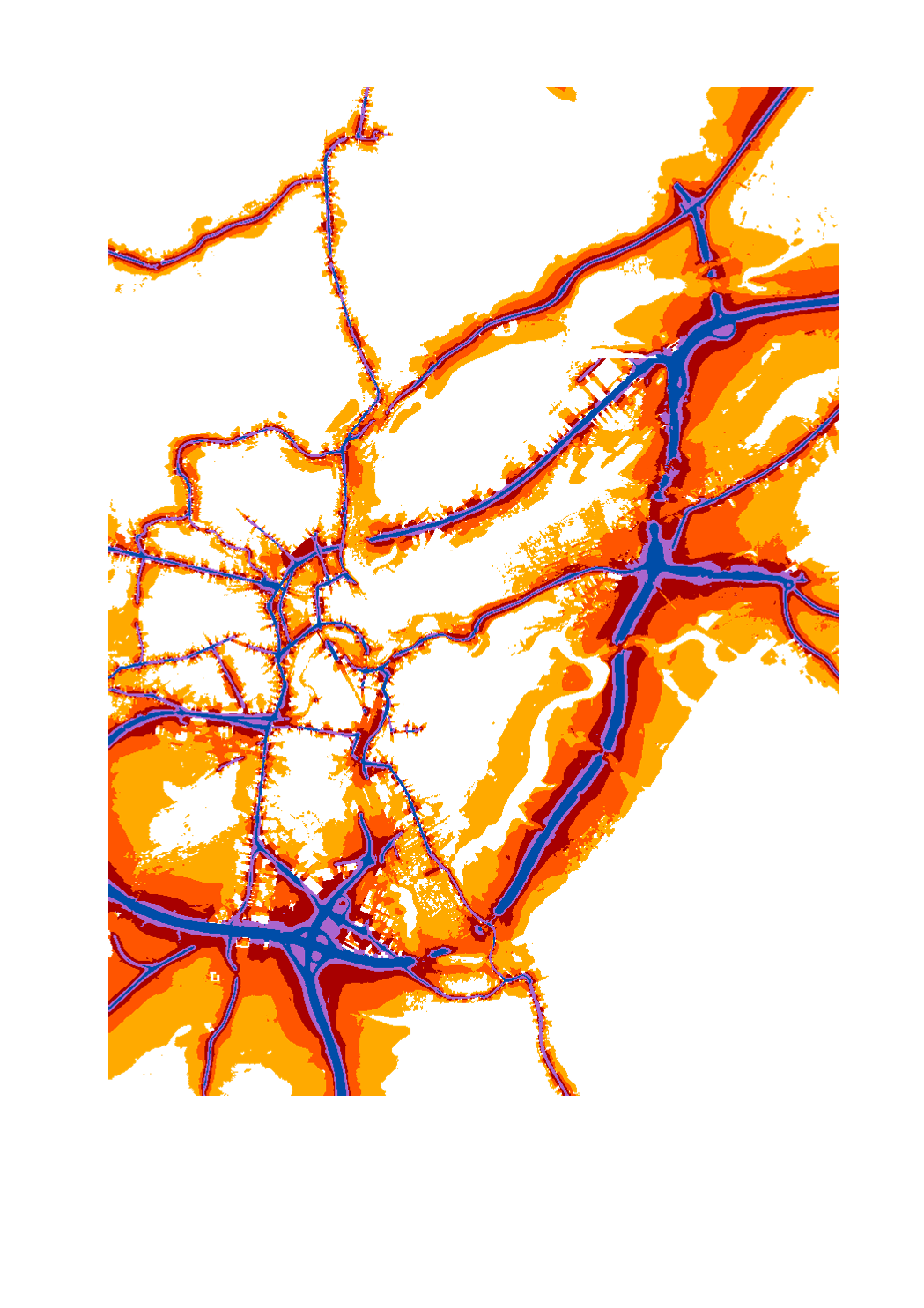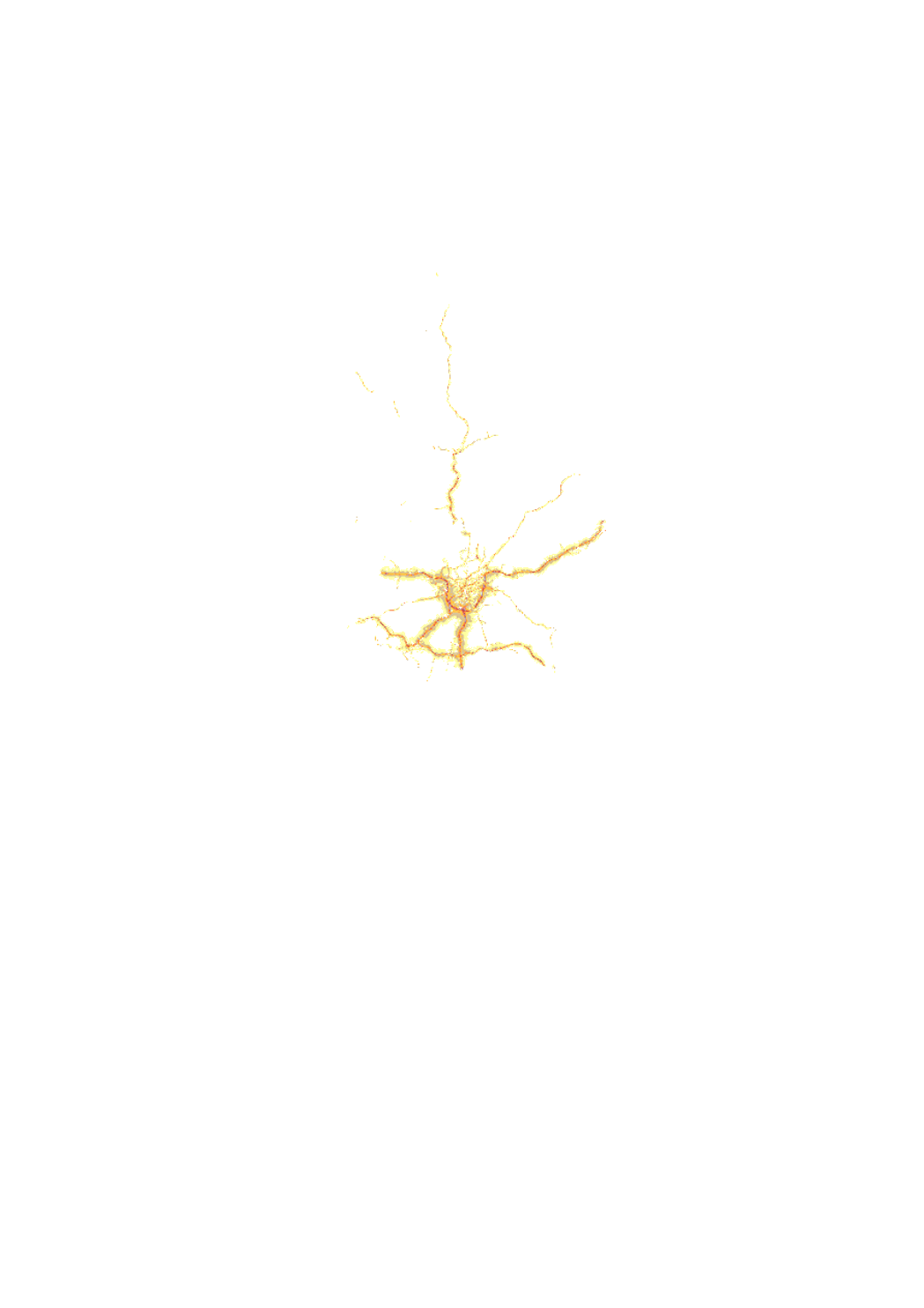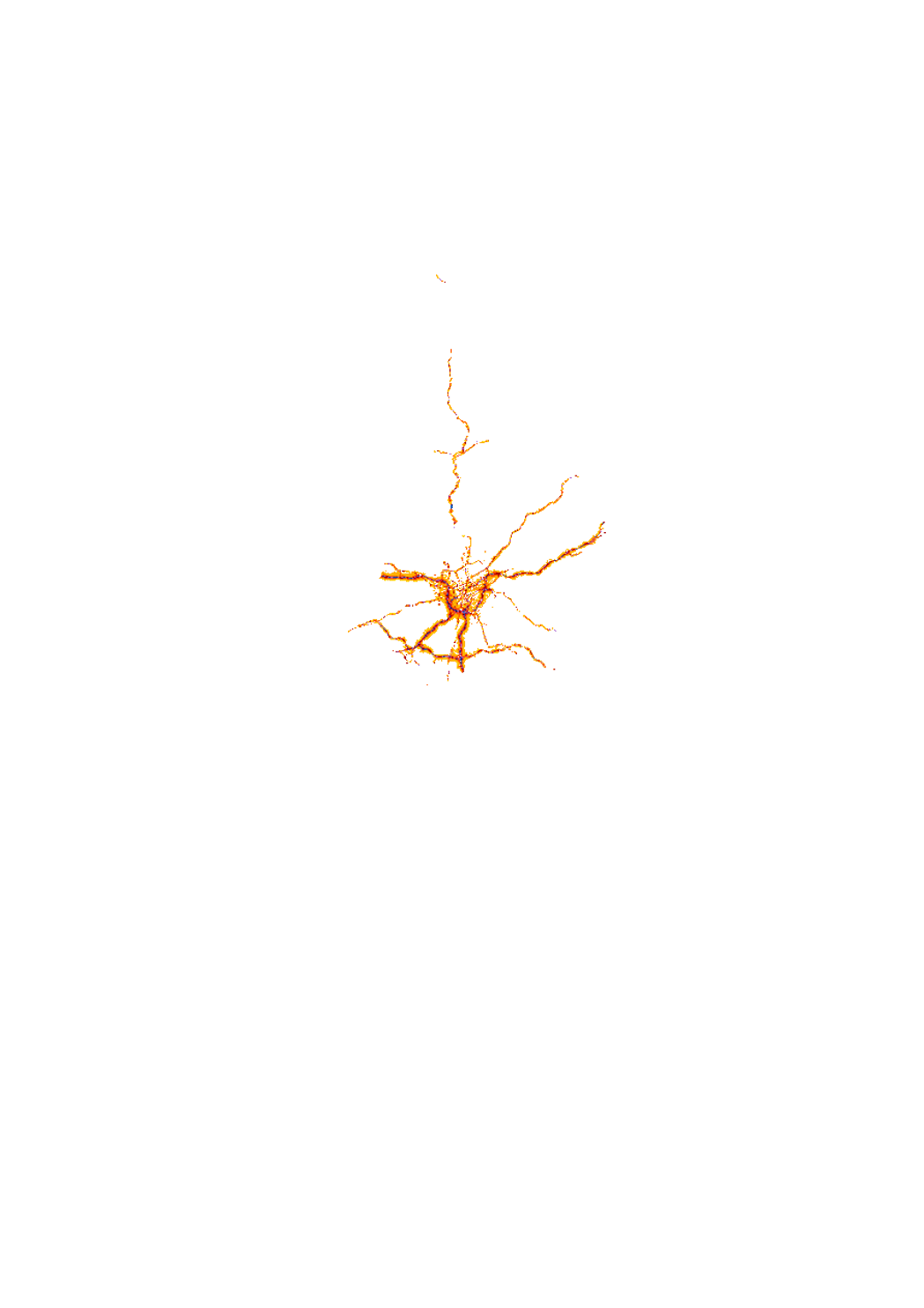PAG>National planning data>human environment>Roads
Type of resources
Available actions
Topics
Keywords
Contact for the resource
Provided by
Groups
Years
Representation types
Update frequencies
status
Scale
-

In order to apply noise hotspot prioritisation factors objectively and systematically, the index UCEden is applied. The Comparative Noise Exposure Unit (UCEden) is an index based on the Lden noise index and is evaluated on the basis of strategic noise mapping. The exposure of a site is characterized according to the number of people disturbed and the Lden level to which these people are exposed. For this purpose, the UCE is defined according to the formula indicated in the legend where the UCEden is without unit, and N corresponds to the number of dwellings on the site, Pi corresponds to the number of persons domiciled at dwelling i, and Li is equal to the noise level Lden at the most exposed façade of dwelling i. Although the Li level is expressed in decibel (dB), the UCEden is actually an indicator without dimension, combining the exposed people and the exposure level of the dwelling they occupy. For more information, please access the elaborated noise action plans at www.emwelt.lu.
-

In order to apply noise hotspot prioritisation factors objectively and systematically, the index UCEden is applied. The Comparative Noise Exposure Unit (UCEden) is an index based on the Lden noise index and is evaluated on the basis of strategic noise mapping. The exposure of a site is characterized according to the number of people disturbed and the Lden level to which these people are exposed. For this purpose, the UCE is defined according to the formula indicated in the legend where the UCEden is without unit, and N corresponds to the number of dwellings on the site, Pi corresponds to the number of persons domiciled at dwelling i, and Li is equal to the noise level Lden at the most exposed façade of dwelling i. Although the Li level is expressed in decibel (dB), the UCEden is actually an indicator without dimension, combining the exposed people and the exposure level of the dwelling they occupy. For more information, please access the elaborated noise action plans at www.emwelt.lu.
-

In order to apply noise hotspot prioritisation factors objectively and systematically, the index UCEden is applied. The Comparative Noise Exposure Unit (UCEden) is an index based on the Lden noise index and is evaluated on the basis of strategic noise mapping. The exposure of a site is characterized according to the number of people disturbed and the Lden level to which these people are exposed. For this purpose, the UCE is defined according to the formula indicated in the legend where the UCEden is without unit, and N corresponds to the number of dwellings on the site, Pi corresponds to the number of persons domiciled at dwelling i, and Li is equal to the noise level Lden at the most exposed façade of dwelling i. Although the Li level is expressed in decibel (dB), the UCEden is actually an indicator without dimension, combining the exposed people and the exposure level of the dwelling they occupy. For more information, please access the elaborated noise action plans at www.emwelt.lu.
-

In accordance with European legislation, the Environment Agency has updated the strategic noise maps for the fourth cycle of Directive 2002/49/EC of the European Parliament and of the Council of 25 June 2002 relating to the assessment and management of environmental noise. These maps refer to the year 2021 and indicate, using a standardised colour scale based on the Lden indicator, the exposure to ambient noise in decibels of major roads with more than 3 million vehicles per year located within the territory of the Grand Duchy of Luxembourg. The indicators used to describe the annoyance caused by exposure to noise are : Lden in decibels (dB), a representative average noise indicator for a 24-hour day, evaluated over a full year and for which the evening period is penalised by 5 dB(A) and the night period is penalised by 10 dB(A); and the Lnight in decibels (dB), a representative average noise indicator for an 8-hour night, assessed over a full year and associated with sleep disturbance. The indicators are based on three periods of the day: a day" period of 12 hours (7am to 7pm), an "evening" period of 4 hours (7pm to 11pm) and a "night" period of 8 hours (11pm to 7am)." https://environnement.public.lu/fr/loft/bruit/valeurs-limites-bruit.html
-

Noise map of all the major roads of more than 3 million vehicles per year located on the territory of the Grand-duchy of Luxemburg and all roads inside of the agglomeration. This map is representative for the year 2016 and is using the noise index LNGT. This noise map has been elaborated in the context of the DIRECTIVE 2002/49/EC OF THE EUROPEAN PARLIAMENT AND OF THE COUNCIL of 25 June 2002 relating to the assessment and management of environmental noise, transposed into national law by the loi du 2 août 2006 modifiant la loi modifiée du 21 juin 1976 relative à la lutte contre le bruit and the règlement grand-ducal du 2 août 2006 portant application de la directive 2002/49/CE relative à l'évaluation et à la gestion du bruit dans l'environnement.
-
.png)
In accordance with European legislation, the Environment Agency has updated the strategic noise maps for the fourth cycle of Directive 2002/49/EC of the European Parliament and of the Council of 25 June 2002 relating to the assessment and management of environmental noise. These maps refer to the year 2021 and indicate, using a standardised colour scale based on the Lngt indicator, the ambient noise exposure in decibels of major roads with more than 3 million vehicles per year located within the territory of the Grand Duchy of Luxembourg. The indicators used to describe the annoyance caused by exposure to noise are : Lden in decibels (dB), a representative average noise indicator for a 24-hour day, evaluated over a full year and for which the evening period is penalised by 5 dB(A) and the night period is penalised by 10 dB(A); and the Lnight in decibels (dB), a representative average noise indicator for an 8-hour night, assessed over a full year and associated with sleep disturbance. The indicators are based on three periods of the day: a day" period of 12 hours (7am to 7pm), an "evening" period of 4 hours (7pm to 11pm) and a "night" period of 8 hours (11pm to 7am)." https://environnement.public.lu/fr/loft/bruit/valeurs-limites-bruit.html
-

In order to apply noise hotspot prioritisation factors objectively and systematically, a new index is introduced. The Comparative Noise Exposure Unit (UCEden) is an index based on the Lden noise index and is evaluated on the basis of strategic noise mapping. The exposure of a site is characterized according to the number of people disturbed and the Lden level to which these people are exposed. For this purpose, the UCE is defined according to the formula indicated in the legend where the UCEden is without unit, and N corresponds to the number of dwellings on the site, Pi corresponds to the number of persons domiciled at dwelling i, and Li is equal to the noise level Lden at the most exposed façade of dwelling i. Although the Li level is expressed in decibel (dB), the UCEden is actually an indicator without dimension, combining the exposed people and the exposure level of the dwelling they occupy. For more information, please access the elaborated noise action plans at www.emwelt.lu.
-

Noise map of all the major roads of more than 3 million vehicles per year located on the territory of the Grand-duchy of Luxemburg and all roads inside of agglomerations. This map is representative for the year 2011 and is using the noise index LDEN. This noise map has been elaborated in the context of the DIRECTIVE 2002/49/EC OF THE EUROPEAN PARLIAMENT AND OF THE COUNCIL of 25 June 2002 relating to the assessment and management of environmental noise, transposed into national law by the loi du 2 août 2006 modifiant la loi modifiée du 21 juin 1976 relative à la lutte contre le bruit and the règlement grand-ducal du 2 août 2006 portant application de la directive 2002/49/CE relative à l'évaluation et à la gestion du bruit dans l'environnement. Attributes: LDEN = 90 -> LDEN 85 - 90 dB(A) LDEN = 85 -> LDEN 80 - 85 dB(A) LDEN = 80 -> LDEN 75 - 80 dB(A) LDEN = 75 -> LDEN 70 - 75 dB(A) LDEN = 70 -> LDEN 65 - 70 dB(A) LDEN = 65 -> LDEN 60 - 65 dB(A) LDEN = 60 -> LDEN 55 - 60 dB(A) LDEN = 55 -> LDEN 50 - 55 dB(A) LDEN = 50 -> LDEN 45 - 50 dB(A)
-

In order to apply noise hotspot prioritisation factors objectively and systematically, a new index is introduced. The Comparative Noise Exposure Unit (UCEden) is an index based on the Lden noise index and is evaluated on the basis of strategic noise mapping. The exposure of a site is characterized according to the number of people disturbed and the Lden level to which these people are exposed. For this purpose, the UCE is defined according to the formula indicated in the legend where the UCEden is without unit, and N corresponds to the number of dwellings on the site, Pi corresponds to the number of persons domiciled at dwelling i, and Li is equal to the noise level Lden at the most exposed façade of dwelling i. Although the Li level is expressed in decibel (dB), the UCEden is actually an indicator without dimension, combining the exposed people and the exposure level of the dwelling they occupy. For more information, please access the elaborated noise action plans at www.emwelt.lu.
-

Noise map of all the major roads of more than 3 million vehicles per year located on the territory of the Grand-duchy of Luxemburg and all roads inside of the agglomeration. This map is representative for the year 2016 and is using the noise index LDEN. This noise map has been elaborated in the context of the DIRECTIVE 2002/49/EC OF THE EUROPEAN PARLIAMENT AND OF THE COUNCIL of 25 June 2002 relating to the assessment and management of environmental noise, transposed into national law by the loi du 2 août 2006 modifiant la loi modifiée du 21 juin 1976 relative à la lutte contre le bruit and the règlement grand-ducal du 2 août 2006 portant application de la directive 2002/49/CE relative à l'évaluation et à la gestion du bruit dans l'environnement.
 geocatalogue.geoportail.lu
geocatalogue.geoportail.lu